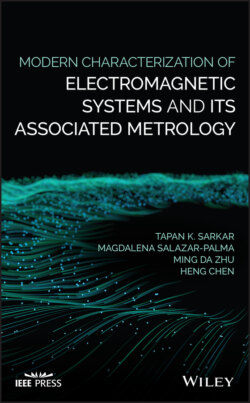Читать книгу Modern Characterization of Electromagnetic Systems and its Associated Metrology - Magdalena Salazar-Palma - Страница 2
Table of Contents
Оглавление1 Cover
2 Title Page
3 Copyright Page
4 Preface
5 Acknowledgments
6 Tribute to Tapan K. Sarkar by Magdalena Salazar Palma, Ming Da Zhu, and Heng Chen
7 1 Mathematical Principles Related to Modern System Analysis Summary 1.1 Introduction 1.2 Reduced‐Rank Modelling: Bias Versus Variance Tradeoff 1.3 An Introduction to Singular Value Decomposition (SVD) and the Theory of Total Least Squares (TLS) 1.4 Conclusion References
8 2 Matrix Pencil Method (MPM) Summary 2.1 Introduction 2.2 Development of the Matrix Pencil Method for Noise Contaminated Data 2.3 Applications of the MPM for Evaluation of the Characteristic Impedance of a Transmission Line 2.4 Application of MPM for the Computation of the S‐Parameters Without any A Priori Knowledge of the Characteristic Impedance 2.5 Improving the Resolution of Network Analyzer Measurements Using MPM 2.6 Minimization of Multipath Effects Using MPM in Antenna Measurements Performed in Non‐Anechoic Environments 2.7 Application of the MPM for a Single Estimate of the SEM‐Poles When Utilizing Waveforms from Multiple Look Directions 2.8 Direction of Arrival (DOA) Estimation Along with Their Frequency of Operation Using MPM 2.9 Efficient Computation of the Oscillatory Functional Variation in the Tails of the Sommerfeld Integrals Using MPM 2.10 Identification of Multiple Objects Operating in Free Space Through Their SEM Pole Locations Using MPM 2.11 Other Miscellaneous Applications of MPM 2.12 Conclusion Appendix 2A Computer Codes for Implementing MPM References
9 3 The Cauchy Method Summary 3.1 Introduction 3.2 Procedure for Interpolating or Extrapolating the System Response Using the Cauchy Method 3.3 Examples to Estimate the System Response Using the Cauchy Method 3.4 Illustration of Extrapolation by the Cauchy Method 3.5 Effect of Noise Contaminating the Data and Its Impact on the Performance of the Cauchy Method 3.6 Generating High Resolution Wideband Response from Sparse and Incomplete Amplitude‐Only Data 3.7 Generation of the Non‐minimum Phase Response from Amplitude‐Only Data Using the Cauchy Method 3.8 Development of an Adaptive Cauchy Method 3.9 Efficient Characterization of a Filter 3.10 Extraction of Resonant Frequencies of an Object from Frequency Domain Data 3.11 Conclusion Appendix 3A MATLAB Codes for the Cauchy Method References
10 4 Applications of the Hilbert Transform – A Nonparametric Method for Interpolation/Extrapolation of Data Summary 4.1 Introduction 4.2 Consequence of Causality and Its Relationship to the Hilbert Transform 4.3 Properties of the Hilbert Transform 4.4 Relationship Between the Hilbert and the Fourier Transforms for the Analog and the Discrete Cases 4.5 Methodology to Extrapolate/Interpolate Data in the Frequency Domain Using a Nonparametric Methodology 4.6 Interpolating Missing Data 4.7 Application of the Hilbert Transform for Efficient Computation of the Spectrum for Nonuniformly Spaced Data 4.8 Conclusion References
11 5 The Source Reconstruction Method Summary 5.1 Introduction 5.2 An Overview of the Source Reconstruction Method (SRM) 5.3 Mathematical Formulation for the Integral Equations 5.4 Near‐Field to Far‐Field Transformation Using an Equivalent Magnetic Current Approach 5.5 Near‐Field to Near/Far‐Field Transformation for Arbitrary Near‐Field Geometry Utilizing an Equivalent Electric Current 5.6 Evaluating Near‐Field Radiation Patterns of Commercial Antennas 5.7 Conclusions References
12 6 Planar Near‐Field to Far‐Field Transformation Using a Single Moving Probe and a Fixed Probe Arrays Summary 6.1 Introduction 6.2 Theory 6.3 Integral Equation Formulation 6.4 Formulation of the Matrix Equation 6.5 Use of an Magnetic Dipole Array as Equivalent Sources 6.6 Sample Numerical Results 6.7 Summary 6.8 Differences between Conventional Modal Expansion and the Equivalent Source Method for Planar Near‐Field to Far‐Field Transformation 6.9 A Direct Optimization Approach for Source Reconstruction and NF‐FF Transformation Using Amplitude‐Only Data 6.10 Use of Computational Electromagnetics to Enhance the Accuracy and Efficiency of Antenna Pattern Measurements Using an Array of Dipole Probes 6.11 A Fast and Efficient Method for Determining the Far Field Patterns Along the Principal Planes Using a Rectangular Probe Array 6.12 The Influence of the Size of Square Dipole Probe Array Measurement on the Accuracy of NF‐FF Pattern 6.13 Use of a Fixed Probe Array Measuring Amplitude‐Only Near‐Field Data for Calculating the Far‐Field 6.14 Probe Correction for Use with Electrically Large Probes 6.15 Conclusions References
13 7 Spherical Near‐Field to Far‐Field Transformation Summary 7.1 An Analytical Spherical Near‐Field to Far‐Field Transformation 7.2 Radial Field Retrieval in Spherical Scanning for Current Reconstruction and NF–FF Transformation 7.3 Conclusion Appendix 7A A Fortran Based Computer Program for Transforming Spherical Near‐Field to Far‐Field References
14 8 Deconvolving Measured Electromagnetic Responses Summary 8.1 Introduction 8.2 The Conjugate Gradient Method with Fast Fourier Transform for Computational Efficiency 8.3 Total Least Squares Approach Utilizing Singular Value Decomposition 8.4 Conclusion References
15 9 Performance of Different Functionals for Interpolation/Extrapolation of Near/Far‐Field Data Summary 9.1 Background 9.2 Approximating a Frequency Domain Response by Chebyshev Polynomials 9.3 The Cauchy Method Based on Gegenbauer Polynomials 9.4 Near‐Field to Far‐Field Transformation of a Zenith‐Directed Parabolic Reflector Using the Ordinary Cauchy Method 9.5 Near‐Field to Far‐Field Transformation of a Rotated Parabolic Reflector Using the Ordinary Cauchy Method 9.6 Near‐Field to Far‐Field Transformation of a Zenith‐Directed Parabolic Reflector Using the Matrix Pencil Method 9.7 Near‐Field to Far‐Field Transformation of a Rotated Parabolic Reflector Using the Matrix Pencil Method 9.8 Conclusion References
16 10 Retrieval of Free Space Radiation Patterns from Measured Data in a Non‐Anechoic Environment Summary 10.1 Problem Background 10.2 Review of Pattern Reconstruction Methodologies 10.3 Deconvolution Method for Radiation Pattern Reconstruction 10.4 Effect of Different Types of Probe Antennas 10.5 Effect of Different Antenna Size 10.6 Effect of Using Different Sizes of PEC Plates 10.7 Extension of the Deconvolution Method to Three‐Dimensional Pattern Reconstruction 10.8 Conclusion Appendix A: Data Mapping Using the Conversion between the Spherical Coordinate System and the Cartesian Coordinate System Appendix B: Description of the 2D‐FFT during the Data Processing References
17 Index
18 End User License Agreement
